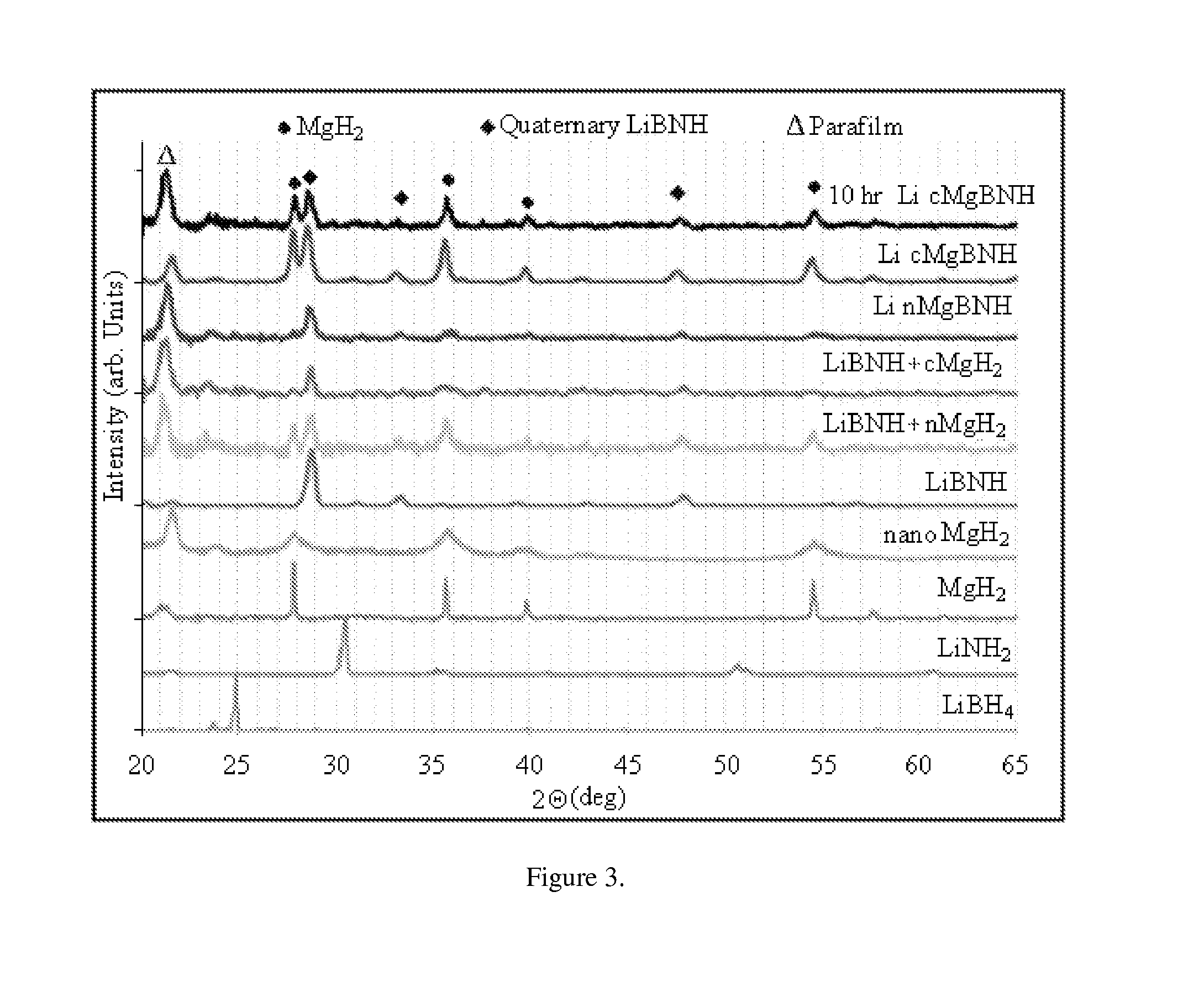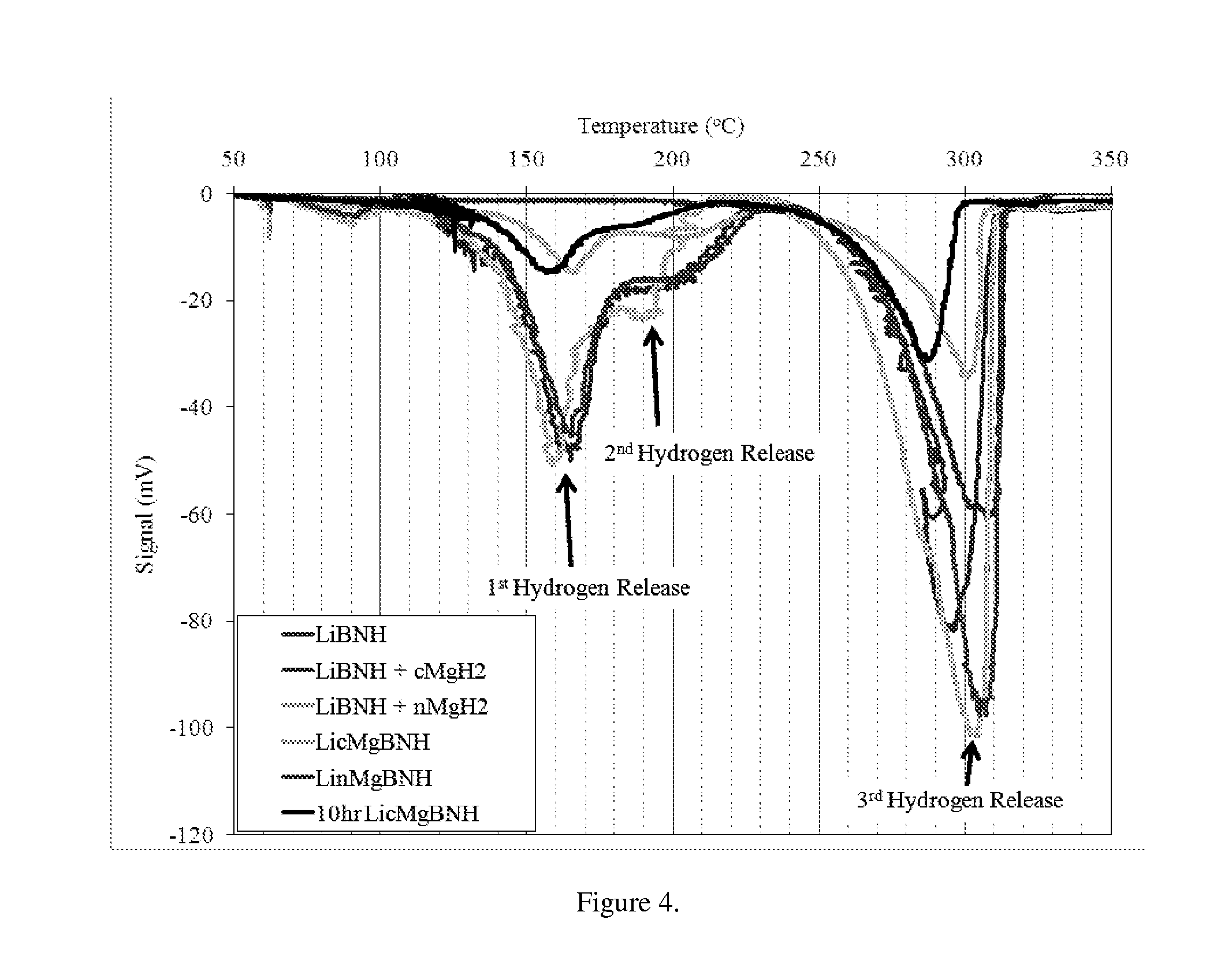Hydrogen-storing hydride complexes
a technology of complexes and hydrogen, applied in the field of complex hydride materials, can solve the problems of affecting the whole of western society, the loss of a reliable supply of fossil fuel, and the inability of people to travel to work, etc., and achieves the effect of lowering the hydrogen decomposition temperature of li—mg—b—n—h, and increasing the rate of dehydrogenation or decomposition of hydrogen
- Summary
- Abstract
- Description
- Claims
- Application Information
AI Technical Summary
Benefits of technology
Problems solved by technology
Method used
Image
Examples
example 1
[0038]Multinary hydrides were synthesized from a quaternary composition of LiBH4 and LiNH2, with ad-mixing of nano MgH2. The parent compounds, LiBH4 and LiNH2, (Sigma Aldrich, purity of at least 95%), and MgH2 (Alfa Aesar, purity of 98%) were kept in an inert atmosphere in a glove box and used without further purification. The investigated samples were created in 4 g batches with a constant molar ratio of 2LiNH2:LiBH4:MgH2, while taking into account the purity of the parent compounds, by employing high energy ball milling (Planetary mill PULVERISETTE 6, Fritsch GmbH, Idar-Oberstein Germany) for 5 hours at 300 rpm with intermittent hydrogen / argon (5% / 95%) purges for 20 minutes before milling and after 2 and 4 hours. This was done to ensure that as little hydrogen as possible was released during the milling process and to reduce the agglomeration of the hydride that occurs when pure hydrogen is used as compared to the hydrogen / argon mixture. The MgH2 was either added as received or wa...
example 2
[0041]X-Ray Diffraction (XRD) was performed to compare the patterns of the five differently processed complex hydrides, seen in FIG. 3. The parent compounds, LiBH4, LiNH2, as well as both commercial and nano MgH2 are in the lower half of the figure as a reference. The peak around 21° C. is from the Parafilm® used to protect the samples during measurement. Neither LiBH4 nor LiNH2 peaks are observed in any of the five samples. This confirms that these two materials are fully consumed during the milling process and actually form a new quaternary structure, referred to as LiBNH.
[0042]The quaternary structure has been reported to be Li4BN3H10 (Pinkerton, F. E.; Meisner, G. P.; Meyer, M. S.; Balogh, M. P.; Kundrat, M. D. The Journal of Physical Chemistry B 2005, 109, 6). The addition of commercial MgH2 does not cause the formation of a new complex structure, but instead indicates that the quaternary structure is preserved, while the MgH2 simply intermixes with the material. When the nano ...
example 3
[0052]The effect of nanomaterial-doping was tested in the complex hydride LiBNH+nMgH2. Each nanomaterial doped hydride was characterized by TPD for its thermal characteristics. As with the multinary structure containing MgH2, a 3-step hydrogen release mechanism is evident, as is shown in FIG. 12. TPD analysis indicates that the material doping has a marked effect on the thermal decomposition characteristics, both increasing hydrogen decomposition of both the hydrogen release peaks, and reducing the temperature of the third hydrogen release. The first hydrogen release peaks between 153.3° C. for LiBNH+nMgH2 and the nanoiron-, nanonickel-, nanocopper-, and nanomanganese-doped LiBNH+nMgH2 compositions and 162° C. for the nanocobalt-doped LiBNH+nMgH2 composition, seen in FIGS. 12 and 13. Investigating the second, or main, peak, of the various samples, temperatures range for main hydrogen release vary from 210° C. for the nanocobalt-doped LiBNH+nMgH2 to about 288° C. LiBNH+nMgH2. Interes...
PUM
| Property | Measurement | Unit |
|---|---|---|
| size | aaaaa | aaaaa |
| size | aaaaa | aaaaa |
| size | aaaaa | aaaaa |
Abstract
Description
Claims
Application Information
 Login to View More
Login to View More - R&D
- Intellectual Property
- Life Sciences
- Materials
- Tech Scout
- Unparalleled Data Quality
- Higher Quality Content
- 60% Fewer Hallucinations
Browse by: Latest US Patents, China's latest patents, Technical Efficacy Thesaurus, Application Domain, Technology Topic, Popular Technical Reports.
© 2025 PatSnap. All rights reserved.Legal|Privacy policy|Modern Slavery Act Transparency Statement|Sitemap|About US| Contact US: help@patsnap.com



